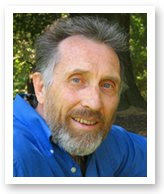Deep breathing. To learn to breathe deeply, you first need to check how you currently take a deep breath. Do this now by standing in front of a mirror. As you take a really deep breath, watch what happens to your upper body and your stomach. You may notice that your upper body will move—if you took a really big breath, you may have raised your shoulders—and your stomach will be drawn in. Although the vast majority of the human race takes a deep breath in this way, it is wrong. It is wrong because it is backwards.
For a truly deep breath to occur, there must be little or no movement in your upper body—and at the same time your stomach must be pushed out. (This "belly breathing" is used by professional musicians.) To learn how to breathe deeply properly, put your hands on your stomach, directly on top of your navel. Now push in. While you are pushing in, push your hands away from your body with your stomach muscles. Then, as you relax your stomach muscles, let your hands push your stomach back in again. This in-and-out movement of your stomach muscles is the same movement that should occur when you breathe deeply.
Now that you have experienced this movement in your stomach muscles, you know which muscles to use for deep breathing. To learn the complete technique of natural deep breathing, follow this simple four- step procedure. (This procedure should always be done by inhaling and exhaling through your mouth.)
- Push your stomach in again with your hands.
- Let the air out of your lungs (be sure to keep your stomach pushed in).
- Now "breathe in, push out" and then
- "breathe out push in."
When you do this for the first time, it should feel different from any other kind of breathing you have experienced before. It may feel either labored or easy depending on how quickly you can adjust to the new coordination of your stomach muscles with your breathing patterns.
Do this several more times so that you can get the feel of what is happening to you. Don't despair if it doesn't come easy. If you are a woman, you have two strikes against you in learning this procedure. First, you must counteract years of physical conditioning. You have been breathing incorrectly for many years, and it may take some time for you to coordinate your muscles.
Second, social conditioning has taught you that, as a woman, "you must never push your stomach out." Let me reassure you that the first problem will take care of itself very quickly. The second is really nonexistent. When you learn to do this naturally, you can deep breathe and nobody will notice it.
Breathing slowly. Now that you have learned to breathe deeply, you must also learn how to breathe more slowly. If you breathe quickly and deeply, you will not get the full benefit of Natural Breathing. You can learn to breathe slowly by simply spelling the word "R-E-L-A-X" to yourself as you breathe in and again as you breathe out. Spell the word silently at the rate of about one letter per second. In this way it will take you about five to six seconds to inhale and the same amount of time to exhale. A total breathe cycle will last about ten to twelve seconds (which means about five or six breaths a minute).
This will probably feel a lot slower than the breathing you are used to. Try this now (using the four-part procedure for deep breathing you just learned) and see how slowly you can breathe. It would be unusual for you to get past the "L" in relax," because most people take in a quick breath and then try to slow it down for the remaining four seconds.
Musicians know that the secret to slow breathing is something called "breath control." When you begin to inhale, do it very gently and gradually, moving your stomach very slowly. You will probably find that controlling the speed of exhaling will be easier than controlling the speed of inhaling.
Breathing discontinuously. Finally, you need to learn how to breathe discontinuously. Listen to your breathing for a few seconds as you normally do it. You will notice that your exhaling and inhaling flow from one to the other. To breathe naturally, you must learn to pause after you exhale and before you take in another breath. How long this pause takes is insignificant. The important factor is that you put a discrete, specific pause between the exhale and the inhale. This pause will help you to further slow down your breathing.
Remember, the pause is the opposite of holding your breath. When you hold your breath, you stop breathing while your lungs are full of air; when you pause, you stop breathing when your lungs empty.
I have named this type of breathing "Natural Breathing" for a good reason: this is the way you naturally breathed when you were born. If you watch a baby on its back, you will notice the little tummy going slowly up and down as it breathes. When the stomach comes down on the exhale, there is a long pause before another breath is taken. So, you see, you are not learning anything new. Rather, you are relearning how to do something that your body considers natural and that which you have been taught not to do.
Now that you know how to breathe naturally, it is imperative that you also learn how to do it automatically. When you are stressed, it can be extremely difficult to remember a half-learned skill. To make Natural Breathing a regular part of your life, you need to practice this skill on a consistent basis.
If you would like to leave a comment, click on the comments link below
For an index of all blogs, go to Blog Index




No comments:
Post a Comment